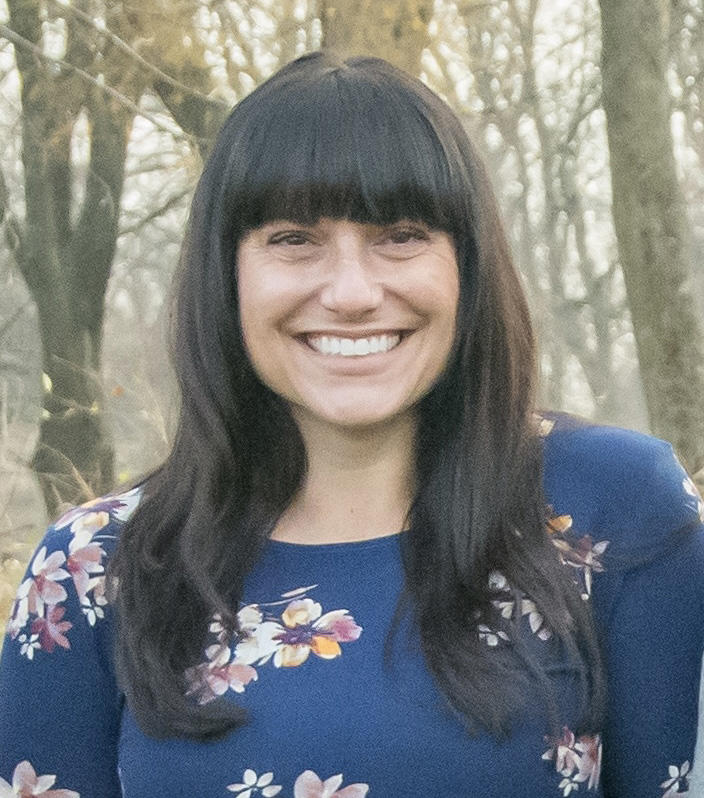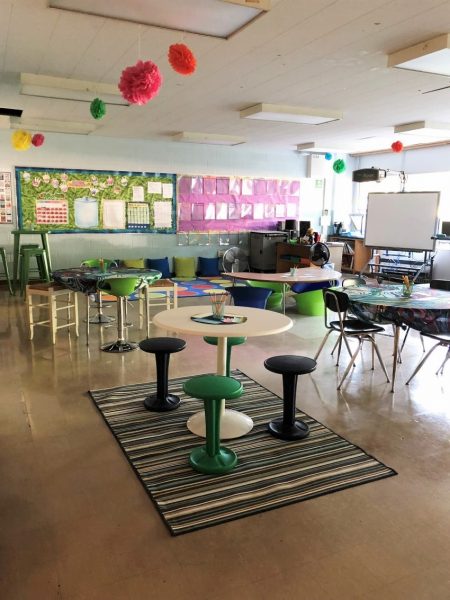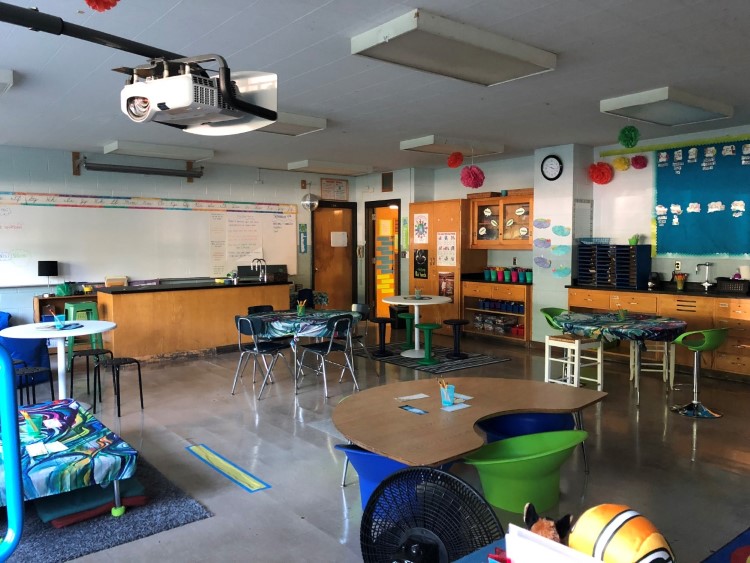Teacher Profile: Jen
Jen Bertrand-LaDuke
Site: MPS Parkside School for the Arts, Grade 3
With her love and enthusiasm of being with kids, Jen Bertrand-LaDuke has worked as an elementary teacher for more than 20 years in Milwaukee Public Schools. After working at Hartford University School for 16 years, Jen decided to make a change and moved to Milwaukee Parkside School for the Arts four years ago because this school “has every single zip code in the city represented and their diversity is amazing.” During the conversation, Jen showed her energy and commitment as an early childhood educator and shared her perspectives on working with children and their families.

In my first year there, everybody had desks in their classrooms. That’s really not how I teach. [The principal asked me], “What do you need from me?” And I said, “I need to get rid of all those desks and chairs. And she was like, “What are you talking about?” I want yoga balls and a big rug because [children] didn’t have rugs. So, I probably spent $500 at IKEA that year just thinking about how I could make it more for the kids.
One of my best friends teaches kindergarten, and she had a lot of different choices for the kids. And I thought, why don’t we have this in the older grades because they are kids, they would ask if they could lay on the floor? I have a yoga mat for every kid in my class, and we do yoga every week. […] I had an ADHD kid, and he did not need meditation. I agreed with the family that he just needed to move and that was fine. So, I found these little fit boards where you can stand on them and you can just twist. And his mom said, that is the most amazing activity for him.

I always say, “You have to learn what your body needs, compared to your social needs of wanting to talk to friend. So, if you can sit and talk with a friend and get your work done, that’s awesome. But if it’s not, you have to self-assess and say, ‘I think I’m going to work over there for a little while, getting back on track, and then next time I can sit next to friends.’” But I don’t ever tell the kids that they have to go back to their home base unless they are not able to self-regulate. [I will say], take a break, you can go to the peace place and get refocused.


I was thinking project-based learning is always my favorite time. We do a Milwaukee project that kids learn about the different neighborhoods in the city, so they each pick a neighborhood that they’re interested in. And we researched, like the history of the neighborhood, how the neighborhood has changed culturally, and we learned about the different cultures that come to Milwaukee and why we have things in Milwaukee because of these cultures. They learned about the architecture, and they built a 3D model of their neighborhoods. They learned songs and dances from the music and dance teachers, and they learned the polka.
We took a tour, the Milwaukee food and city tour. We went to the neighborhoods that we’ve learned about, and the kids got to see what they’ve actually learned about in their neighborhoods. They made cultural dolls. We talked about the idea about traditional cultural clothing. And I had paper towel, paper tubes and little foam pieces, and they paint, tried to make and cut the skin tones and hot glue fabrics, pretty elaborate.
We invited families in for a family night, and each family brought in a cultural dish. And these families came, and they were so proud of their meal. And then, the kids presented their work, they presented their Google slideshow of everything they’ve learned, because they asked questions like what else they want to know about this neighborhood. So, families got to see everybody’s work. And we did a little walking museum and the kids performed their song and dance, and their artwork like their weaving.
[This project] takes three months, it’s my whole third trimester. I think it’s a big deal. And the field trip is always like our last big hurrah. I think the best part is, they’re saying, “I never knew that Milwaukee could be fun.” Because a lot of kids never leave their neighborhood and their little block.
“I go with play because they still need that.”
I have STEM activity buckets, like a bucket of blocks and straws, magna-tiles, and all the things you would probably see in a traditional kindergarten classroom. In the first month of school, we have some time at the end of the day, for about 30 minutes every day [to play], because we have to learn in the environment where it’s not structured. They need to [figure out] how we’re going to play together, how we’re going to be in this community, and how we’re going to work through problems and share.
For this school, kids really just want to play. So [I just] give them that opportunity. My favorite quote is that they said at the end of the year, “third grade didn’t even seem like we were learning, it was just so fun, and it didn’t even seem like school”. My attendance is always so high because they want to come to school, and they know they’re able to play and choose and talk to their friends.
I like to put my ELL kids in reading groups so that they can be with the other kids that are speaking. . .[I had a kid] from Mexico and he knows a couple words. We’re going to [put him in reading group]. And then, I’m crying when he’s reading a third-grade book and he’s reading with the kids. It’s not about the test, it was about them feeling confident. He felt confident and safe in the environment, and he was able to make those mistakes that he needed to grow.
I’m just constantly walking around and taking notes while they’re working. So then, I know how to group them, and how to help them work in like a reading group. I have a clipboard with their name and what the standard is, it’ll say, kids that get it, kids that need support and kids that have no clue.
The kids keep a portfolio, and they have their own little grade books with the assignment, the date, and what they scored the first time. And they always have opportunities to score better, and their project-based learning sheet has every standard on there circled. They have a goal-setting sheet because I do SMART goals with the kids. They reflect on areas where they are strong, what they want to focus on, how they think they’re going to reach the goal. So, when the parents come in, we sit down and open up the portfolio, and the kids talk about their grades and progress because they even put their star data in there for themselves. I’m not a data wall person but they know where they are and how they’re growing, and they can tell you where their strong points and what they need to work on.
I think everything is about working with families, you get to know the whole child when you know their family. I always write in my letters to my family, we work together, and we support each other, that’s how we reach the kids out.
I use the remind app so I’m able to text families, and there’s a voice button. So, my English as a second language families that are not comfortable with English can speak because they feel better speaking. They can just speak to me, and I can speak back, and they understand that better, which has been great for building relationships with families. [It helps] me work with families so that they still feel that they’re part of it because sometimes they feel disconnected because US schools [are] different and they’re not used to it and the language.
And I do my own family nights just for our community because I want parents to be able to come and celebrate their kids. I feel like you get to know why this child is doing this because they just moved two times, and the families feel comfortable telling you those things. If they don’t feel comfortable telling me those things, I don’t know [and] then I can’t support their child in the way that the child needs, so I just need them to know that I’m a safe place. “You can tell me, it’s confidential. We’re going to work towards what’s best for your kid.”
Asking the kids and having the kids be part of the conversation. When they’re doing ecosystems, [I would ask], “What do you want to learn about ecosystems, instead of me.” I will say, “These are the standards that we get to learn about, and we’re going to get there, but I want you to tell me how you get there. This is our standard that we’re working towards a goal, how are you going to show that you’re going to reach the standard. Instead of me having to think like how I can work this, I rather like saying, “you tell me what”.
If it was something where they had to talk, they’d say, we’re going to mind our own business and stay on topics so that we can stay focused and reach our goal. For example, they’d say, “We’re going to keep our volume in a volume two because we can get all excited when we get to work and do this activity.” [If they don’t], then my management would be so easy, I will say, “hey friends, do you remember you said you were going to keep your volume at two? Okay, let’s make sure we reach our goal today”. That’s like turning it over to my kids and then they internalize that, and they know that’s my goal and that’s what I said I was going to do.
People have this idea that small children can’t have big ideas or can’t handle big content like Google Slides, or writing a song. Like they wrote a rap and then recorded it, made it, and did the beats. They used what the music teacher taught them, [like] how to use the beat maker for their songs. You just give them the opportunity and see what they can do.
I think it’s interesting that we spend so much money on the curriculum or the content, but we don’t spend any money on play items, teachers have to buy their own STEM activities and [materials] like refrigerators, their own dress-up clothing. We spend so much money on these textbooks. And we don’t spend any money on the ideas of what’s going to make the kid’s growth, and we don’t spend money on those SEL resources, those play, those STEM.
We need somebody who is going to say, “okay, now we need funds allotted for a classroom teacher, and I will trust that classroom teacher”. We need somebody in there that says, this is important. If you build this community and build a safe environment, you have the right to give the kids these opportunities and knowledge that you’ll actually see that growth happen. We need somebody at the upper level that is able to see the classroom that have this happening and have the test scores to manage.
